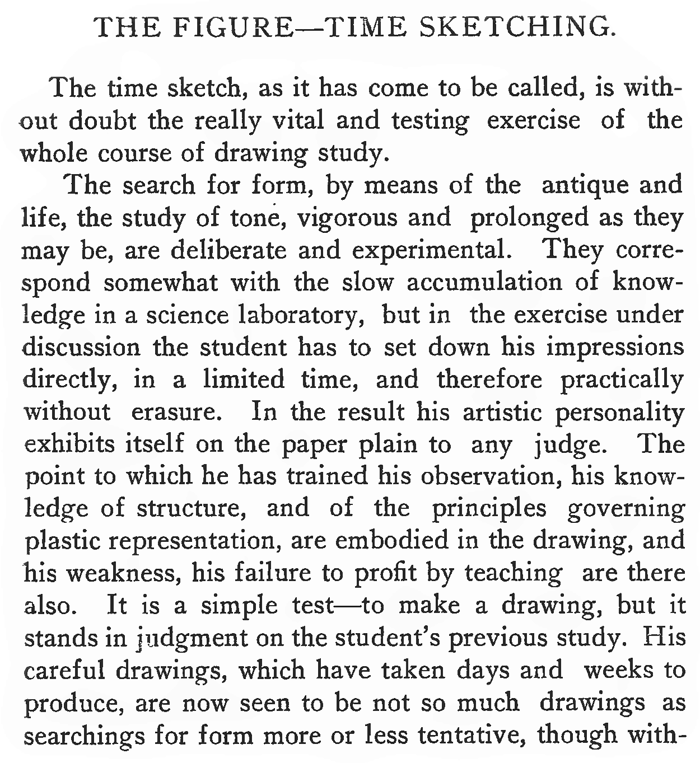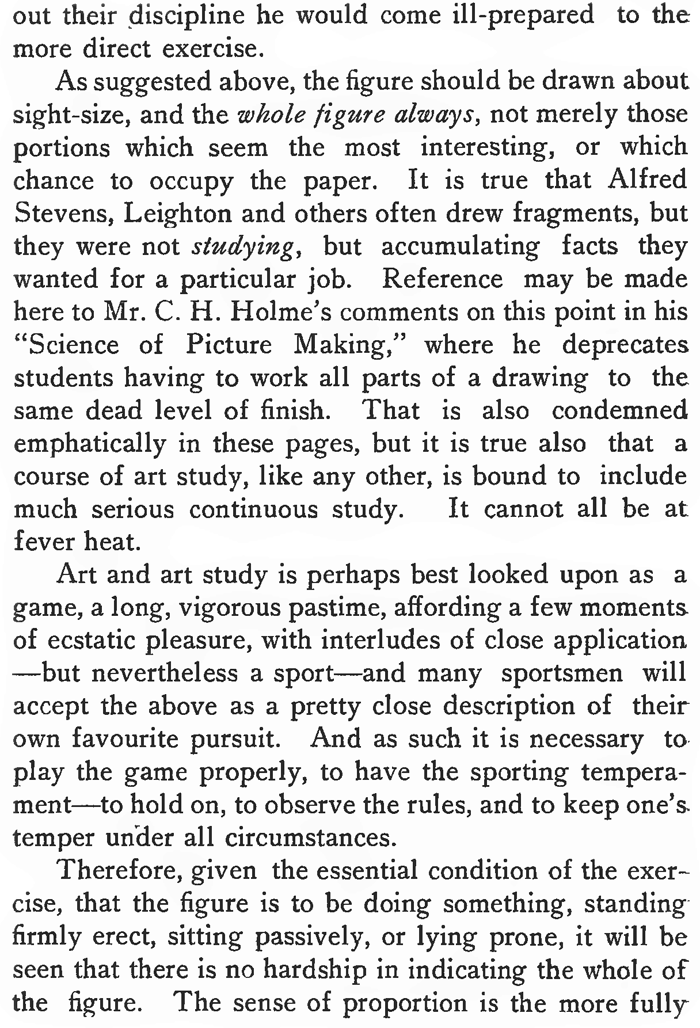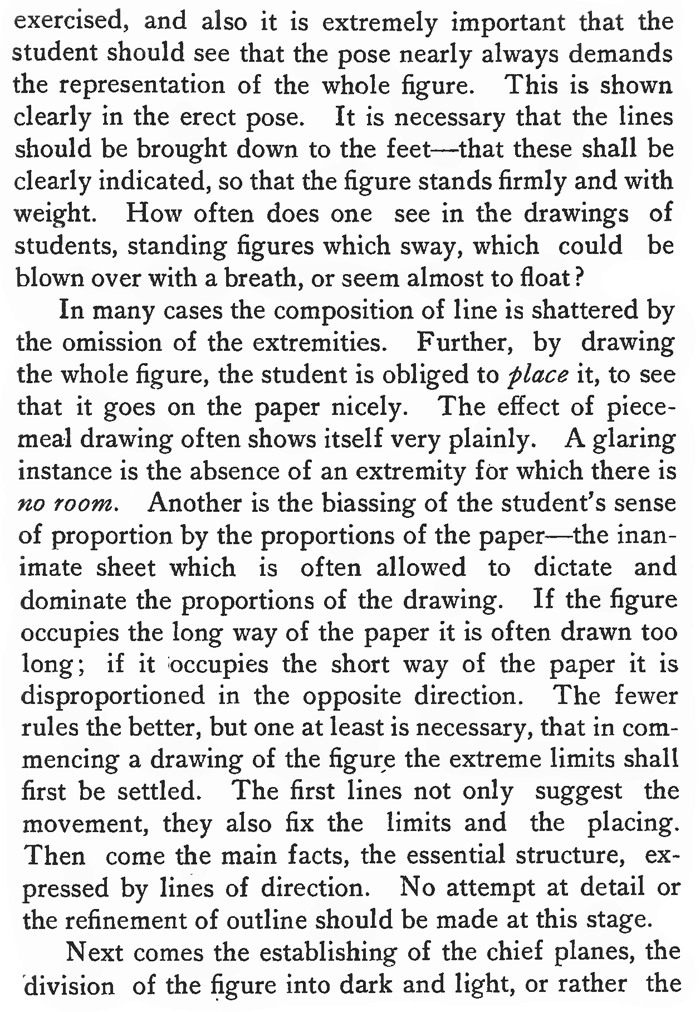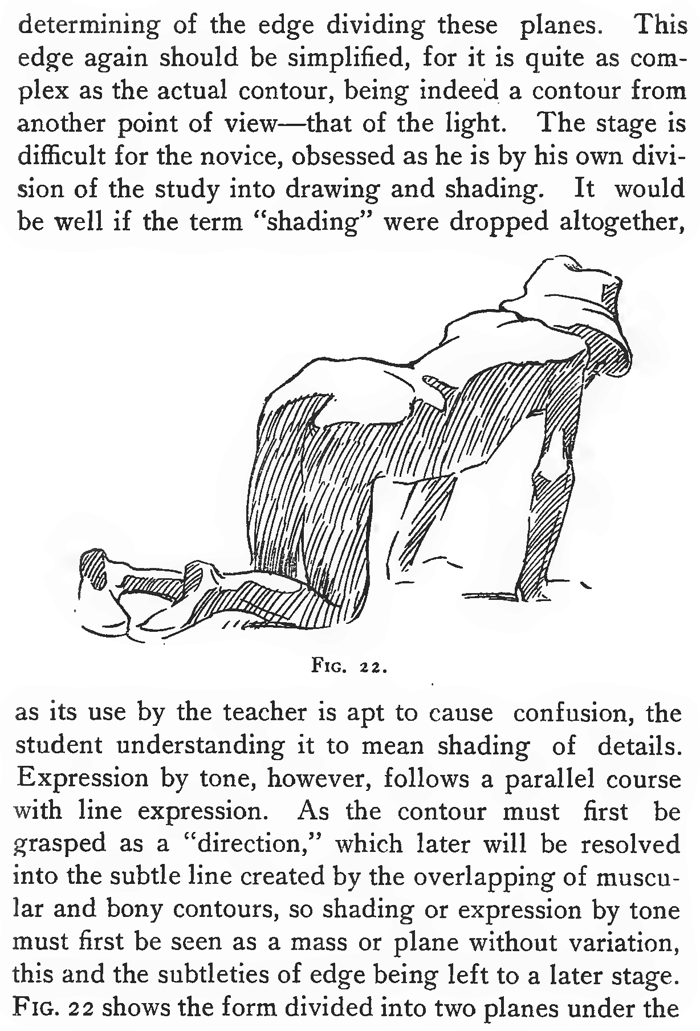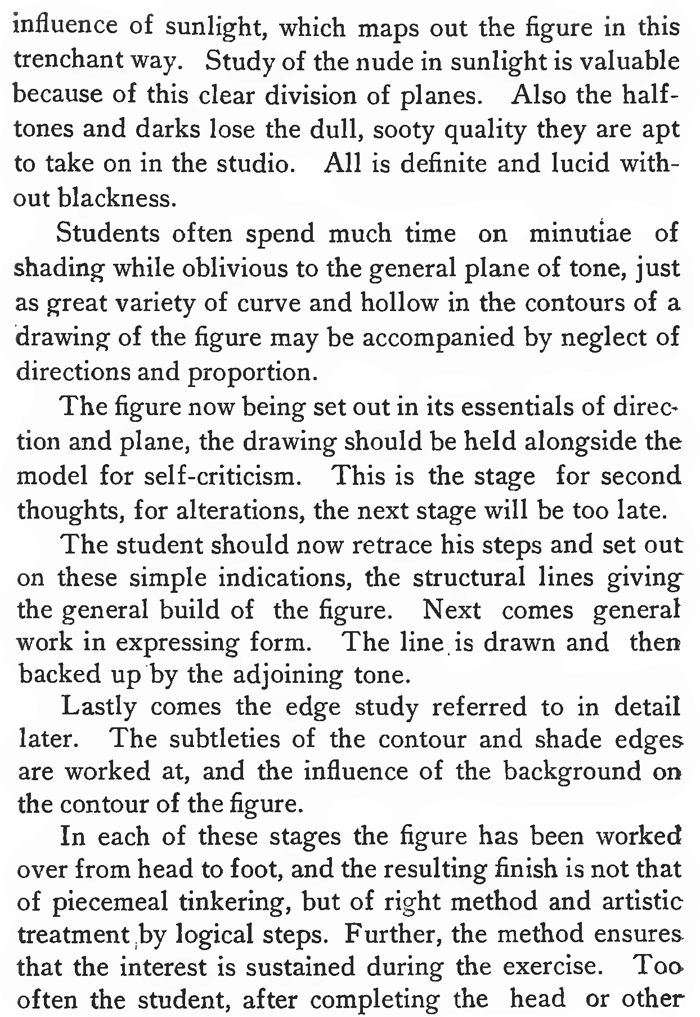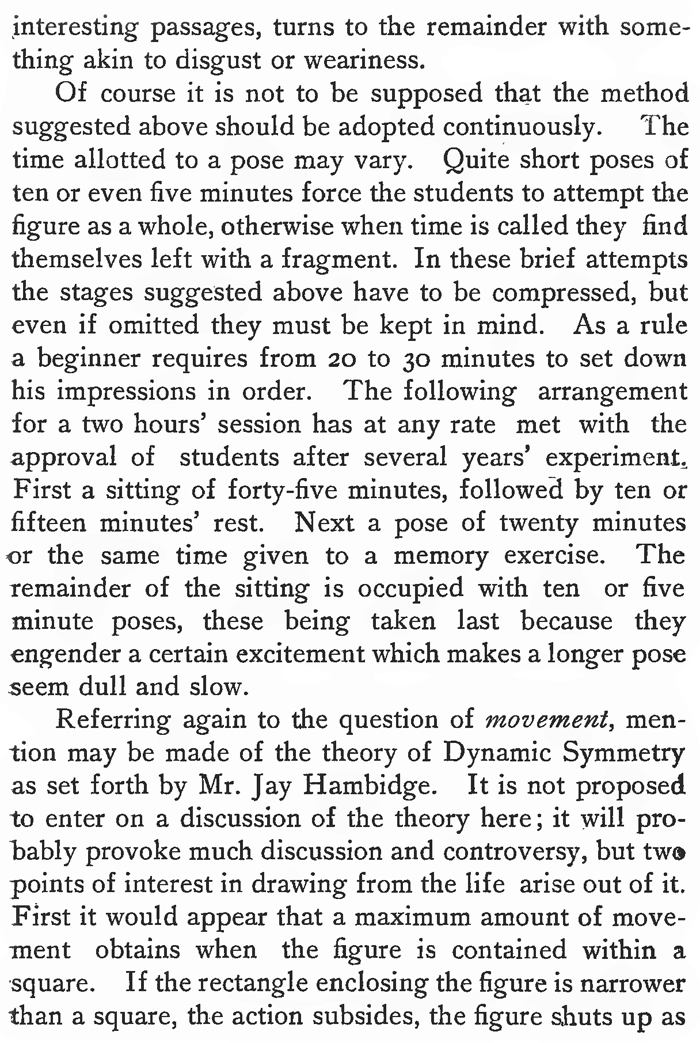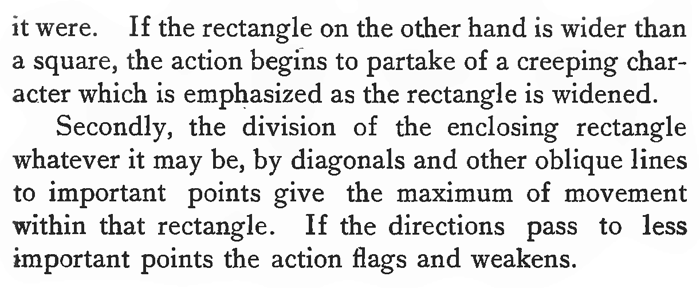Home > Directory of Drawing Lessons> How to Draw People > How to Draw Figure Time Sketches
rapid figure sketching exercise : How to Sketch People & Figures with Timed Sketching Exercises
|
|
THE HUMAN FIGURE—TIME SKETCHINGThe time sketch, as it has come to be called, is without doubt the really vital and testing exercise of the whole course of drawing study. The search for form, by means of the antique and life, the study of tone, vigorous and prolonged as they may be, are deliberate and experimental. They correspond somewhat with the slow accumulation of knowledge in a science laboratory, but in the exercise under discussion the student has to set down his impressions directly, in a limited time, and therefore practically without erasure. In the result his artistic personality exhibits itself on the paper plain to any judge. The point to which he has trained his observation, his knowledge of structure, and of the principles governing plastic representation, are embodied in the drawing, and his weakness, his failure to profit by teaching are there also. It is a simple test—to make a drawing, but it stands in judgment on the student's previous study. His careful drawings, which have taken days and weeks to produce, are now seen to be not so much drawings as searchings for form more or less tentative, though with As suggested above, the figure should be drawn about sight-size, and the whole figure always, not merely those portions which seem the most interesting, or which chance to occupy the paper. It is true that Alfred Stevens, Leighton and others often drew fragments, but they were not studying, but accumulating facts they wanted for a particular job. Reference may be made here to Mr. C. H. Holme's comments on this point in his "Science of Picture Making," where he deprecates students having to work all parts of a drawing to the same dead level of finish. That is also condemned emphatically in these pages, but it is true also that a course of art study, like any other, is bound to include much serious continuous study. It cannot all be at fever heat. Art and art study is perhaps best looked upon as a game, a long, vigorous pastime, affording a few moments of ecstatic pleasure, with interludes of close application —but nevertheless a sport—and many sportsmen will accept the above as a pretty close description of their own favorite pursuit. And as such it is necessary to play the game properly, to have the sporting temperament—to hold on, to observe the rules, and to keep one's temper udder all circumstances. Therefore, given the essential condition of the exercise, that the figure is to be doing something, standing firmly erect, sitting passively, or lying prone, it will be seen that there is no hardship in indicating the whole of the figure. The sense of proportion is the more fully exercised, and also it is extremely important that the student should see that the pose nearly always demands the representation of the whole figure. This is shown clearly in the erect pose. It is necessary that the lines should be brought down to the feet—that these shall be clearly indicated, so that the figure stands firmly and with weight. How often does one see in the drawings of students, standing figures which sway, which could be blown over with a breath, or seem almost to float? In many cases the composition of line is shattered by the omission of the extremities. Further, by drawing the whole figure, the student is obliged to place it, to see that it goes on the paper nicely. The effect of piecemeal drawing often shows itself very plainly. A glaring instance is the absence of an extremity for which there is no room. Another is the biasing of the student's sense of proportion by the proportions of the paper—the inanimate sheet which is often allowed to dictate and dominate the proportions of the drawing. If the figure occupies the long way of the paper it is often drawn too long ; if it occupies the short way of the paper it is disproportioned in the opposite direction. The fewer rules the better, but one at least is necessary, that in commencing a drawing of the figure the extreme limits shall first be settled. The first lines not only suggest the movement, they also fix the limits and the placing. Then come the main facts, the essential structure, expressed by lines of direction. No attempt at detail or the refinement of outline should be made at this stage. Next comes the establishing of the chief planes, the division of the figure into dark and light, or rather the determining of the edge dividing these planes. This edge again should be simplified, for it is quite as complex as the actual contour, being indeed a contour from another point of view—that of the light. The stage is difficult for the novice, obsessed as he is by his own division of the study into drawing and shading. It would be well if the term "shading" were dropped altogether, as its use by the teacher is apt to cause confusion, the student understanding it to mean shading of details. Expression by tone, however, follows a parallel course with line expression. As the contour must first be grasped as a "direction," which later will be resolved into the subtle line created by the overlapping of muscular and bony contours, so shading or expression by tone must first be seen as a mass or plane without variation, this and the subtleties of edge being left to a later stage. FIG. 22 shows the form divided into two planes under the influence of sunlight, which maps out the figure in this trenchant way. Study of the nude in sunlight is valuable because of this clear division of planes. Also the halftones and darks lose the dull, sooty quality they are apt to take on in the studio. All is definite and lucid without blackness. Students often spend much time on minutiae of shading while oblivious to the general plane of tone, just as great variety of curve and hollow in the contours of a drawing of the figure may be accompanied by neglect of directions and proportion. The figure now being set out in its essentials of direction and plane, the drawing should be held alongside the model for self-criticism. This is the stage for second thoughts, for alterations, the next stage will be too late. The student should now retrace his steps and set out on these simple indications, the structural lines giving the general build of the figure. Next comes general work in expressing form. The line, is drawn and then backed up by the adjoining tone. Lastly comes the edge study referred to in detail later. The subtleties of the contour and shade edges are worked at, and the influence of the background on the contour of the figure. Of course it is not to be supposed that the method suggested above should be adopted continuously. The time allotted to a pose may vary. Quite short poses of ten or even five minutes force the students to attempt the figure as a whole, otherwise when time is called they find themselves left with a fragment. In these brief attempts the stages suggested above have to be compressed, but even if omitted they must be kept in mind. As a rule a beginner requires from 20 to 30 minutes to set down his impressions in order. The following arrangement for a two hours' session has at any rate met with the approval of students after several years' experiment. First a sitting of forty-five minutes, followed by ten or fifteen minutes' rest. Next a pose of twenty minutes or the same time given to a memory exercise. The remainder of the sitting is occupied with ten or five minute poses, these being taken last because they engender a certain excitement which makes a longer pose seem dull and slow. Referring again to the question of movement, mention may be made of the theory of Dynamic Symmetry as set forth by Mr. Jay Hambidge. It is not proposed to enter on a discussion of the theory here ; it will probably provoke much discussion and controversy, but two points of interest in drawing from the life arise out of it. First it would appear that a maximum amount of movement obtains when the figure is contained within a square. If the rectangle enclosing the figure is narrower than a square, the action subsides, the figure shuts up as it were. If the rectangle on the other hand is wider than a square, the action begins to partake of a creeping character which is emphasized as the rectangle is widened. Secondly, the division of the enclosing rectangle whatever it may be, by diagonals and other oblique lines to important points give the maximum of movement within that rectangle. If the directions pass to less important points the action flags and weakens.
|





